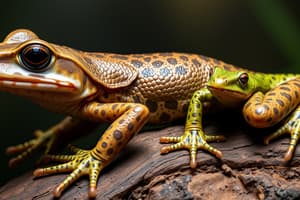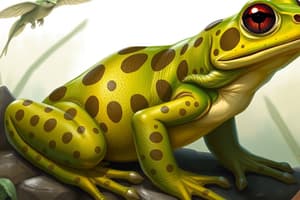Podcast
Questions and Answers
Which amphibian typically undergoes indirect development with a tadpole stage?
Which amphibian typically undergoes indirect development with a tadpole stage?
- Salamanders
- Caecilians
- Frogs (correct)
- Newts
In which environment do amphibians commonly lay their eggs?
In which environment do amphibians commonly lay their eggs?
- In water (correct)
- Deserts
- In trees
- On dry land
What is the fertilization process primarily used by most frogs?
What is the fertilization process primarily used by most frogs?
- Asexual reproduction
- External fertilization (correct)
- Internal fertilization
- Parthenogenesis
What is the role of the nasolacrimal duct in anuran amphibians believed to be related to?
What is the role of the nasolacrimal duct in anuran amphibians believed to be related to?
What reproductive strategy do newts often utilize?
What reproductive strategy do newts often utilize?
Which part of the amphibian brain is primarily responsible for the integration of behavior and learning?
Which part of the amphibian brain is primarily responsible for the integration of behavior and learning?
What function does the medulla oblongata serve in the amphibian nervous system?
What function does the medulla oblongata serve in the amphibian nervous system?
Which sensory organ in amphibians is responsible for receiving vibrations from external environments?
Which sensory organ in amphibians is responsible for receiving vibrations from external environments?
In which amphibian group is vision notably diminished, as they are nearly blind?
In which amphibian group is vision notably diminished, as they are nearly blind?
What role does the pineal body play in amphibians?
What role does the pineal body play in amphibians?
What forms from the fusion of the ulna and radius in frogs?
What forms from the fusion of the ulna and radius in frogs?
Which of the following structures is not part of the frog's respiratory system?
Which of the following structures is not part of the frog's respiratory system?
What type of circulation do frogs possess?
What type of circulation do frogs possess?
Where does urine travel after being formed in the kidneys of frogs?
Where does urine travel after being formed in the kidneys of frogs?
What is the primary nitrogenous waste excreted by adult frogs?
What is the primary nitrogenous waste excreted by adult frogs?
Which of the following components of the circulatory system is found in frogs?
Which of the following components of the circulatory system is found in frogs?
What is the role of the frog's cloaca?
What is the role of the frog's cloaca?
How do tadpoles primarily breathe before they develop lungs?
How do tadpoles primarily breathe before they develop lungs?
What significant evolutionary milestone marks amphibians as the first terrestrial animals?
What significant evolutionary milestone marks amphibians as the first terrestrial animals?
What feature distinguishes amphibian eggs from amniotic eggs?
What feature distinguishes amphibian eggs from amniotic eggs?
Which of the following does NOT describe a characteristic of amphibians?
Which of the following does NOT describe a characteristic of amphibians?
Which respiratory method is used by amphibians during their larval stage?
Which respiratory method is used by amphibians during their larval stage?
What structural feature of amphibian skeletons indicates their classification in Tetrapoda?
What structural feature of amphibian skeletons indicates their classification in Tetrapoda?
What type of respiration do adult amphibians primarily rely on?
What type of respiration do adult amphibians primarily rely on?
Which statement about the vertebral column of amphibians is True?
Which statement about the vertebral column of amphibians is True?
What is a common misconception about amphibians' method of reproduction?
What is a common misconception about amphibians' method of reproduction?
Which of the following statements about the classification of amphibians is true?
Which of the following statements about the classification of amphibians is true?
Which amphibian listed is categorized as a part of the order Anura?
Which amphibian listed is categorized as a part of the order Anura?
What is the term for the process where an organism reproduces while in its larval stage?
What is the term for the process where an organism reproduces while in its larval stage?
Which amphibian is known for having external gills throughout its life?
Which amphibian is known for having external gills throughout its life?
What physiological state is characterized by low metabolic rate and inactivity during certain seasons?
What physiological state is characterized by low metabolic rate and inactivity during certain seasons?
Which of the following amphibians is capable of being neotenic?
Which of the following amphibians is capable of being neotenic?
Which of the following is NOT a species of the order Caudata?
Which of the following is NOT a species of the order Caudata?
Which characteristic is associated with the state of hibernation in amphibians?
Which characteristic is associated with the state of hibernation in amphibians?
Flashcards
Radio-Ulna
Radio-Ulna
The ulna and radius bones in the forearm are fused together, forming a single structure.
Tibio-Fibula
Tibio-Fibula
The tibia and fibula bones in the lower leg are fused together, forming a single structure.
Ribless Frogs
Ribless Frogs
Frogs lack ribs and a diaphragm, so they breathe differently compared to mammals.
Frog's Tongue
Frog's Tongue
Signup and view all the flashcards
Cloaca
Cloaca
Signup and view all the flashcards
Three-Chambered Heart
Three-Chambered Heart
Signup and view all the flashcards
Pulmonary & Systemic Circulation
Pulmonary & Systemic Circulation
Signup and view all the flashcards
Frog Breathing
Frog Breathing
Signup and view all the flashcards
What are amphibians?
What are amphibians?
Signup and view all the flashcards
What is unique about the life stages of amphibians?
What is unique about the life stages of amphibians?
Signup and view all the flashcards
What makes amphibians anamniotes?
What makes amphibians anamniotes?
Signup and view all the flashcards
What makes amphibians tetrapods?
What makes amphibians tetrapods?
Signup and view all the flashcards
How do amphibians breathe throughout their life?
How do amphibians breathe throughout their life?
Signup and view all the flashcards
Describe the skin of an amphibian.
Describe the skin of an amphibian.
Signup and view all the flashcards
What does it mean that amphibians are cold-blooded?
What does it mean that amphibians are cold-blooded?
Signup and view all the flashcards
What is a cloaca in amphibians?
What is a cloaca in amphibians?
Signup and view all the flashcards
Amphibian Brain
Amphibian Brain
Signup and view all the flashcards
Jacobson's Organ
Jacobson's Organ
Signup and view all the flashcards
Nictitating Membrane
Nictitating Membrane
Signup and view all the flashcards
Lateral Line
Lateral Line
Signup and view all the flashcards
Mesonephros Kidneys
Mesonephros Kidneys
Signup and view all the flashcards
Vomeronasal Organ (Jacobson's Organ)
Vomeronasal Organ (Jacobson's Organ)
Signup and view all the flashcards
Sensory Tentacle in Caecilians
Sensory Tentacle in Caecilians
Signup and view all the flashcards
External Fertilization
External Fertilization
Signup and view all the flashcards
Internal Fertilization
Internal Fertilization
Signup and view all the flashcards
Indirect Development (Amphibians)
Indirect Development (Amphibians)
Signup and view all the flashcards
Anura
Anura
Signup and view all the flashcards
Neoteny
Neoteny
Signup and view all the flashcards
Pedogenesis
Pedogenesis
Signup and view all the flashcards
Caudata
Caudata
Signup and view all the flashcards
Hibernation
Hibernation
Signup and view all the flashcards
Metabolism
Metabolism
Signup and view all the flashcards
Endotherm
Endotherm
Signup and view all the flashcards
Heterothermy
Heterothermy
Signup and view all the flashcards
Study Notes
Amphibia
- First terrestrial animals, evolved from lobed fish 370 million years ago.
- Live in water in larval stage (tadpole) and on land as adults.
- Anamniota - eggs lack protective membranes or shells; laid in water.
Characteristic Features
- Adults are terrestrial, larvae are aquatic.
- Lack protective membranes on eggs.
- Gas exchange in eggs occurs through vitelline membranes, involved in oxygen and carbon dioxide exchange
- Important group, including cyclostomes, fishes, and amphibians.
- Four limbs (Tetrapoda).
- Adults breathe with lungs; larvae with gills.
- Skin is smooth, moist, and often glandular, sometimes poisonous; various colors and patterns.
- Breathe through skin (cutaneous respiration).
- Cold-blooded (exothermic).
- Have cloaca (a single opening for the digestive, excretory, and reproductive systems).
Skeletal System
- Vertebral column consists of fused vertebrae (cervical, sacral, urostyle).
- Atlas (one of the first two cervical vertebrae) unique in amphibians-
- Ulna and radius are fused to form a single bone.
- Tibia and fibula are fused to form a single bone.
- Frogs lack ribs and diaphragm.
Digestive System
- Features include mouth, buccal cavity, teeth, tongue, pharynx, esophagus, stomach, liver, pancreas, gall bladder, small and large intestine and a cloaca.
Respiratory System
- Frogs breathe through lungs and skin (skin must stay moist)
- Lungs are not efficient for supplying all oxygen.
- Buccal cavity assists in respiration.
- Tadpoles breathe via gills.
Circulatory System
- Closed circulatory system.
- Three-chambered heart (two atria and one ventricle).
- Imperfect double circulation: pulmonary and systemic. Developed lymphatic system.
- Deoxygenated blood from body to the right atrium, then to the ventricle.
- Mixing of oxygenated and deoxygenated blood in ventricle.
- Blood circulates to lungs and body via the aorta.
Excretory System
- Kidneys are mesonephric.
- Filter wastes (urea) from the blood; combine with water to form urine.
- Urine leaves the body through the cloaca.
- Tadpoles excrete ammonia.
Nervous System
- Brain consists of cerebrum, midbrain, cerebellum, olfactory lobe, optic lobe, optic lobe, cerebellum, oblongata.
- Controls body functions like heart rate, respiration, and movement.
- Pineal body involved in hibernation and estivation.
Senses
- Good sight (except those with adaptations to cave life).
- Nictitating membrane covers the eyes.
- Good hearing—inner ear is well-developed.
- Olfactory bulbs and Jacobson's organ for smell.
Reproduction
- Mostly external fertilization, eggs laid in water.
- Fertilization varies based on species (external or internal)
- Development (Tadpole stage is involved).
- Indirect development, with a larval phase.
Classification
- Divided into three orders: Anura (frogs), Caudata (newts), and Gymnophiona (caecilians).
Additional Notes
- Specific video links for further study are included within the original excerpt's text. Note, these notes omit the videos.
Studying That Suits You
Use AI to generate personalized quizzes and flashcards to suit your learning preferences.




